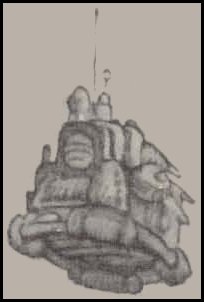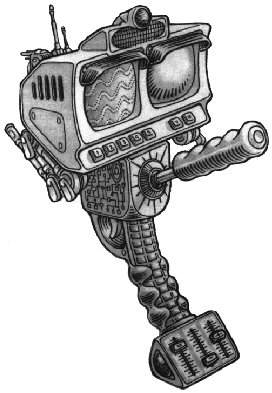
| REMOTE EXPEDITION SURVEY ROBOT | |
| LEVEL: | 4 |
| BODY TYPE: | Heavy Duty |
| MOVEMENT: | 4 mechanical legs for surface movement; enclosed modified jetcopter engine for aerial movement |
| SPEED: | 20 kph on surface; 350 kph/50 kph airborne |
| RANGE: | 1000 km or 1000 minutes hovering or any combination adding up to 1000 |
| LIMBS: | 2 mechanical arms, each with the strength of about 5 men |
| PROGRAMS: | Attack/Defense Computer Link Topographical Survey Sample Collection Photo Survey Site Maintenance |
| BATTERY: | Type 2 |
| STAMINA: | 500 points |
| WEAPONS: | 1 heavy laser, turret mounted with 100 SEU power pack; 1 automatic rifle, turret mounted with 100 rounds, fires bursts of 10 rounds, with basic chance to hit of 70%. Field of fire for both weapons is 180 degrees forward. |
| The lander module carries three of these robots. They were designed to remain with the robot research station in the lander after the Moraes leaves. Thereafter, they carry out many tasks: collecting soil, water and plant samples, conducting photo surveys, mapping, etc. These robots are durably built to withstand terrific punishment, since repair is impossible once the expedition ship leaves. Each robot has a surplus lifting capacity of 50 kg,. but no provision for transporting anything bulkier than small survey samples. These robots have attack/defense programs to help protect the expedition. the attack program's first priority is to attack a designated target. The second priority is to defend against attackers not specifically designated as targets. The defense program directs automatic attacks against intruders entering a forbidden area (defined by a specific command). "Intruder(s)" may be specified by detailed descriptions. The automatic attacks are conducted first against the closest intruder, and second against other intruders. | |

This device provides remote radio control of a survey robot. Each robot has its own specific controller to avoid receiving conflicting commands. The controller includes a joystick and a two-way radio for verbal commands. Two miniature video screens project visible-light and infra-red views from five robot-mounted cameras. Each controller can operate in three modes:
(source- Alpha Dawn Expanded)